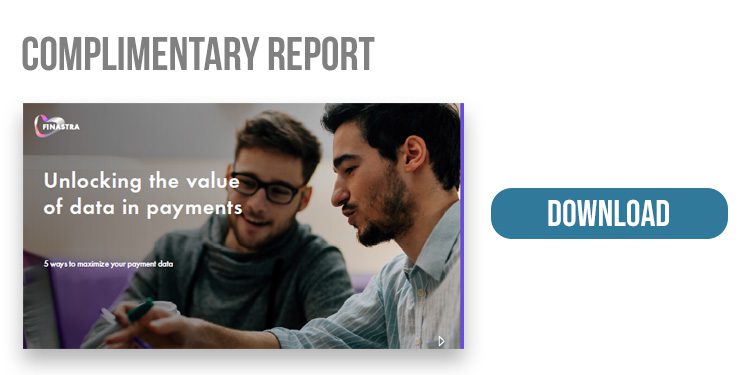News flash: banks have access to a ton of data.
If this data is harnessed effectively, it can open doors for new revenue streams and a better customer experience. Surprisingly, most banks are not taking full advantage of the large volumes of payments data that is already at their fingertips. A change is happening, however, as many financial institutions are starting to look at the opportunities this data presents.
In a recent report by Finastra, Unlocking the Value of Data in Payments, experts discuss data best practices and how to use that data without ‘breaking the bank.’
How to harness data effectively
Many non-bank providers seem to have mastered the art of data sharing, leaving banks concerned about their ability to keep up with the competition. Banks are now looking for insights that may provide a competitive edge, but a one-size-fits-all approach won’t cut it because each institution is at a different stage of their data sharing journey.
If banks want to hold their own in the payments arena, they must first expand their horizons, thinking more broadly about the different ways data can be used for a multitude of purposes. To their advantage, banks have the entire economy flowing through their systems every day, which means they have access to a large pool of data.
On the other hand, many of these same banks don’t quite comprehend how to best use data analytics, and their experience with silos may prevent data from being shared across the institution.
To make the best use of data, banks must consider breaking down silos, harnessing existing data, bringing in external data, and democratizing data.
Leveraging data for a better customer experience
It is clear that banks can use data to their advantage, especially when it comes to enhancing the customer experience. However, banks often choose not to implement the practice of harnessing data more effectively because they have the preconceived notion that the process is costly and time consuming. This is not necessarily the case because banks already have a significant amount of data available within their institutions.
Banks can use the data in their possession to review client behavior and better understand what the customer needs. For example, the bank may be able to use existing customer data to recognize that a customer purchased a sophisticated integrated receivables solution but is only using it to process checks. This is a small step that can make a big difference.
Additionally, banks can take advantage of more sophisticated tools to assist customers in identifying future opportunities for transformation. Consider this: AI can help banks make real-time predictions and use data in a more predictive way. This can aid banks in supporting their clients with things like cash flow forecasting and working capital management in a more effective way.
But while there is the opportunity for banks to explore more ambitious avenues, they shouldn’t feel pressured to make too many changes at once. Starting small and working toward a more innovative platform is the best route to take.
The starting line for banks
There is a lot of talk about leveraging data more effectively, but how are banks supposed to know where to start? When creating a prototype, the needs of the customers should always come first.
Executives spend an extensive amount of time and resources on piloting specific use cases and building prototypes, but these are often developed without considering how they can be implemented on a bigger scale and brought to fruition. Also challenging is the development of business cases outside of the big picture and the lack of consideration for the future evolution of the payments landscape.
By putting the needs of the customers first, banks can develop solutions that are based on real business needs, making it easier to scale up prototypes. They should also consider how to harness data in a way that can apply to both current and future landscape situations and challenges.
Most importantly, banks need to understand that data doesn’t have to be a giant project with an outrageous monetary investment. It can be as simple as reviewing the data that is already available and interacting with it to determine how to use that data to bring value to the bank.
Takeaway
Both the adoption of ISO 20022 and the rise of instant payments have accelerated the digitization of the payments landscape. Banks need to consider how they can gain more value from existing data to enhance the customer experience, or risk being overshadowed by fintechs.
However, different banks are at different points on their journeys, and those institutions that continue to use outdated silos may require a more intense focus on cross-functional collaboration. Sophisticated tools and technology can help on the road to change.
There are many opportunities for banks to use technology to take better advantage of their data. For example, AI can be used for real-time fraud detection, and cloud services are often used to improve agility and reduce cost of ownership. Open APIs are also offering new opportunities for banks to work with fintechs and gain a better insight into customer behavior.
Interested in learning more about how banks can harness data to their advantage? Download the white paper below!












